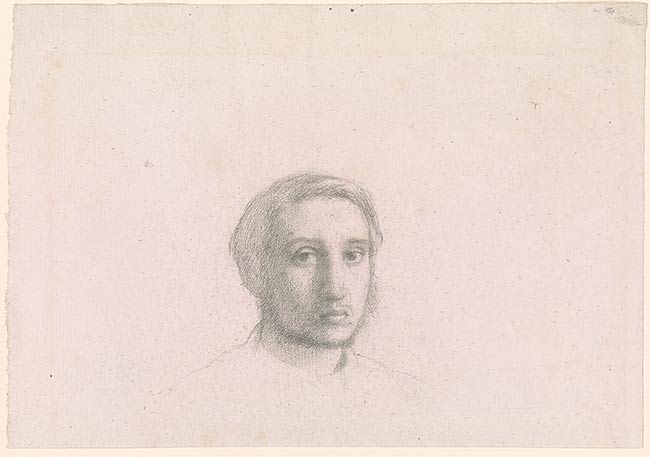

A series of self-portraits, drawn and painted, emerged from Degas's youthful period before 1859. In July 1856, when he was twenty-two years old, he left Paris for his first visit to Italy, where he remained for three years. During this period, he frequently used himself as a model, and the resulting studies capture the artist's likeness and curiosity and chronicle his early development. These personal, exploratory works mostly remained in Degas's studio throughout his life. Among the contents of his studio after his death were two sheets now in the Morgan collection: the present study and a second sheet containing a self-portrait with additional studies of the artist's hand and eye (2017.117). Both sheets are cropped--one is an upper half, the other a lower--of two different sheets from what must be the same stock of paper. The use of a French paper strengthens the argument that Degas made these contemplative studies in Paris before his departure. Yet it is as likely that he brought a stock of French paper to Italy.
In both sheets, Degas depicted himself with the solemnity of a Renaissance portrait, opting to sketch with soft black chalk, exploiting its rich and shadowy sfumato, rather than using graphite to achieve Ingresque precision. The common paper and delicate handling of both sheets of sketches suggest they were executed at approximately the same time; the proximity of their execution prompted their being mounted together and sold in a single lot in the sale of Degas's niece Jeanne Fevré's collection. On the lower sheet, the secondary study of a hand emerging from a billowing sleeve reveals the inspiration of Renaissance portraiture. It is likely a study of Degas's left hand resting on his portfolio of drawings. Likewise, the focused study of his left eye indicates his still student-like efforts to master details. The use of the page is closer to sheets in Degas's many notebooks than his preparatory drawings, suggesting the exploratory function of such studies.
Connecting these two sheets of studies and Degas's painted self-portraits from these early years is tempting. The artist's focus on the modeling of his face, neglecting the body, is consistent with his approach in several of the painted self-portraits. Sheets such as the present, however, are likely independent explorations by the artist and not directly preparatory for works in other media and formats, which are similar but do not correspond exactly. The present studies are akin to the Morgan's 1856 Self-Portrait in a Brown Vest (Lemoisne 13), which was likely executed before the artist left for Italy. Both sketches explore the near side of the face deep in shadow, while the oil sketch reverses this pattern. Regarding lighting, however, the sketches are closer to a study in oils in the Baltimore Museum of Art (Lemoisne 14; c. 1856).
Stamped in red ink on verso, Atelier Ed. Degas (encircled; Lugt 657).
Guérin, Marcel, 1873-1948, former owner.
Guérin, Daniel, former owner.
Thaw, Eugene Victor, former owner.
Thaw, Clare, former owner.
Thaw Catalogue Raisonné, 2017, no. 76, repr.
Stampfle, Felice, and Cara D. Denison. Drawings from the Collection of Mr. and Mrs. Eugene V. Thaw. New York : Pierpont Morgan Library, 1975, no. 90.
100 Master drawings from the Morgan Library & Museum. München : Hirmer, 2008, no. 88, repr. [Jennifer Tonkovich]
Lemoisne, Paul-André. Degas Et Son Oeuvre. Paris: Paul Brame Et C.M. De Hauke, 1946.
